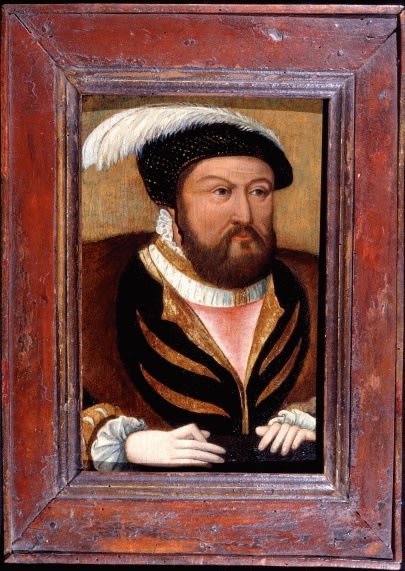
Anglo-Netherlandish School
Portrait of King Henry VIII (1491-1547), c. 1535
Oil on oak panel
11 ½ x 8 in. (29.2 x 24 cm)
Philip Mould & Co.
To view all current artworks for sale visit philipmould.com The image of King Henry VIII is most familiar to posterity through the paintings of Holbein, and through the mass of...
To view all current artworks for sale visit philipmould.com
The image of King Henry VIII is most familiar to posterity through the paintings of Holbein, and through the mass of images produced in the century after the King's death which derive from the 1537 Whitehall Palace mural type. This was not, however, how he was most commonly depicted in his lifetime, and, until the advent of Holbein, Henry was best known to his subjects through a variety of other images. This present small painting was executed by a native Anglo-Flemish workshop in the mid-1530s, and is comparable to an example in the National Portrait Gallery (NPG 1376). The artist shows himself competent both in depicting both the King's likeness -the narrow eyes, long, straight nose and small mouth are at once recognisable- but also in the painting of drapery and costume. The fur collar of the King's gown is admirably suggested, as is the rich lining at the open collar and slashes of his doublet.
The interest of this portrait lies not least in its indisputable dating to within the King's lifetime -which is rarely the case with the mass of images after Holbein- and therefore of its particular place within the history of Henry's reign. The iconic images of Holbein belong to a period when Henry believed himself secure in his dynasty, in his establishment of the church and when his more turbulent dealings with the Continental powers had been resolved. This image, however, was executed immediately subsequent to the turbulent, earlier years. It was most probably painted whilst the King was still married to Anne Boleyn, and is, therefore, an intriguing glimpse of the man, who had at first courted her in the early years of the decade and married her officially in 1533, before becoming disenchanted by her failure to produce a living son. The consequence of this displeasure is celebrated. Influenced by the opposing party at Court he came to dislike Anne, and was prepared to believe the allegations of adultery and even witchcraft that led to her execution for treason in 1536.
The image of King Henry VIII is most familiar to posterity through the paintings of Holbein, and through the mass of images produced in the century after the King's death which derive from the 1537 Whitehall Palace mural type. This was not, however, how he was most commonly depicted in his lifetime, and, until the advent of Holbein, Henry was best known to his subjects through a variety of other images. This present small painting was executed by a native Anglo-Flemish workshop in the mid-1530s, and is comparable to an example in the National Portrait Gallery (NPG 1376). The artist shows himself competent both in depicting both the King's likeness -the narrow eyes, long, straight nose and small mouth are at once recognisable- but also in the painting of drapery and costume. The fur collar of the King's gown is admirably suggested, as is the rich lining at the open collar and slashes of his doublet.
The interest of this portrait lies not least in its indisputable dating to within the King's lifetime -which is rarely the case with the mass of images after Holbein- and therefore of its particular place within the history of Henry's reign. The iconic images of Holbein belong to a period when Henry believed himself secure in his dynasty, in his establishment of the church and when his more turbulent dealings with the Continental powers had been resolved. This image, however, was executed immediately subsequent to the turbulent, earlier years. It was most probably painted whilst the King was still married to Anne Boleyn, and is, therefore, an intriguing glimpse of the man, who had at first courted her in the early years of the decade and married her officially in 1533, before becoming disenchanted by her failure to produce a living son. The consequence of this displeasure is celebrated. Influenced by the opposing party at Court he came to dislike Anne, and was prepared to believe the allegations of adultery and even witchcraft that led to her execution for treason in 1536.
1
of
3